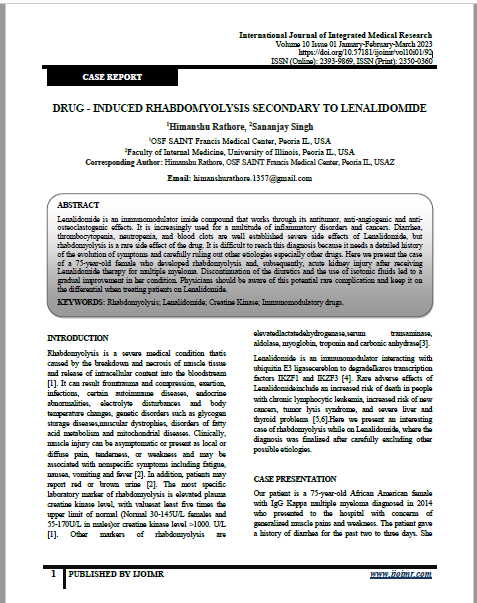Drug-Induced Rhabdomyolysis Secondary To Lenalidomide
Main Article Content
Abstract
Abstract
Lenalidomide is an immunomodulator imide compound that works through its antitumor, anti-angiogenic, and anti-osteoclastogenic effects. It is increasingly used for a multitude of inflammatory disorders and cancers. Diarrhea, thrombocytopenia, neutropenia, and blood clots are well-established severe side effects of Lenalidomide, but rhabdomyolysis is a rare side effect of the drug. It is difficult to reach this diagnosis because it needs a detailed history of the evolution of symptoms and carefully ruling out other etiologies, especially other drugs. Here we present the case of a 75-year-old female who developed rhabdomyolysis and, subsequently, acute kidney injury after receiving Lenalidomide therapy for multiple myeloma. Discontinuation of the diuretics and the use of isotonic fluids led to a gradual improvement in her condition. Physicians should be aware of this potential rare complication and keep it on the differential when treating patients on Lenalidomide.
Article Details
References
• Cabral BMI, Edding SN, Portocarrero JP, Lerma EV. Rhabdomyolysis. Dis Mon. 2020;66(8):101015. doi:10.1016/j.disamonth.2020.101015
• Cervellin G, Comelli I, Lippi G. Rhabdomyolysis: historical background, clinical, diagnostic and therapeutic features. Clin Chem Lab Med. 2010;48(6):749-756. doi:10.1515/CCLM.2010.151
• Brancaccio P, Lippi G, Maffulli N. Biochemical markers of muscular damage. Clin Chem Lab Med. 2010;48(6):757-767. doi:10.1515/CCLM.2010.179
• Barrio S, Munawar U, Zhu YX, et al. IKZF1/3 and CRL4CRBN E3 ubiquitin ligase mutations and resistance to immunomodulatory drugs in multiple myeloma. Haematologica. 2020;105(5):e237-e241. doi:10.3324/haematol.2019.217943
• Myelodysplastic syndromes treatment: Revlimid® (lenalidomide). REVLIMID® (lenalidomide) Patient Site. (2021, November 1). Retrieved December 4, 2022, from https://www.revlimid.com/mds
• Kotchetkov R, Masih-Khan E, Chu CM, et al. Secondary primary malignancies during the lenalidomide-dexamethasone regimen in relapsed/refractory multiple myeloma patients. Cancer Med. 2017;6(1):3-11. doi:10.1002/cam4.799
• Shahan JL, Panu LD, Hildebrandt GC. Rhabdomyolysis in a multiple myeloma patient secondary to concurrent treatment with lenalidomide and pravastatin and to lenalidomide alone. Int J Hematol. 2012;96(6):818-819. doi:10.1007/s12185-012-1226-3
• Ema. (2022, December 6). Revlimid. European Medicines Agency. Retrieved December 4, 2022, from https://www.ema.europa.eu/en/medicines/human/EPAR/revlimid
• Gandhi AK, Kang J, Capone L, et al. Dexamethasone synergizes with lenalidomide to inhibit multiple myeloma tumor growth, but reduces lenalidomide-induced immunomodulation of T and NK cell function. Curr Cancer Drug Targets. 2010;10(2):155-167. doi:10.2174/156800910791054239
• November 15, 2022, November 2, 2022, & October 6, 2022. (n.d.). New use for lenalidomidein multiple myeloma. National Cancer Institute. Retrieved December 4, 2022, from https://www.cancer.gov/news-events/cancer-currents-blog/2017/fda-lenalidomide-myeloma-maintenance
